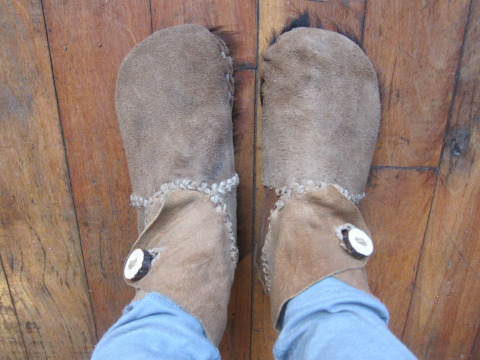Planned Relevance

Exhibit A: Basket being useful. Check the snow against the hoop house!
A couple nights ago we pulled our butt-sprung couch up to the computer and sunk ourselves down into its pile of worn, torn, and forlorn cushions. Penny propped up her worn, torn, and forlorn appendage in all its raw and glistening glory, and we watched a short documentary I’d heard about a ways back called The Lightbulb Conspiracy.
In short, the film is about planned obsolescence, and one of the first documented efforts to engineer planned obsolesce into consumer products. As you’ve probably figured out by now that effort, coordinated by numerous manufacturers in the late 1920′s, was aimed at light bulbs. Apparently, many of the early bulb designs had a fatal flaw: They lasted too long. And because they lasted too long, they did not need frequent replacement. And because they did not need frequent replacement, consumers didn’t do what consumers are expected to do in the post industrial revolution economy: Consume. Or consume enough, at least.
As the movie documents, what happened to lightbulbs – which was to cut their lifespan by more than half – happened to numerous products over the years. Appliances. Textiles. Electronics, certainly. Still, perhaps the most profound example of planned obsolescence is the planned obsolescence of manipulated emotion. The vast majority of consumer waste is generated not because something wears out or is broken (although there’s plenty of that, too), but because the buyer simply wants something newer. This desire – one that is entirely fabricated by the consortium of mass media and the social pressures this messaging gives rise to – can be seen across a broad spectrum of industries, perhaps most notably fashion and technology.
Anyway. It wasn’t until this morning that I realized how perfectly the planned obsolescence of consumer products dovetails with something Penny and I have been talking about a whole bunch recently: Usefulness. I’ve written in this space about how important it is for children to feel useful, and about how enabling our sons to feel this way as often and much as possible is a defining motivation for our decision to allow them to learn at home. But just recently, and perhaps not inconsequential to the fact that I’ve lately been spending the bulk of my days at my desk and therefore not engaged with the land as much as I’ve become accustomed to, I’ve been struck by my own need to feel useful. And by “useful” I mean in a hands-dirty, sweat-streaked way. I mean with muscles and soil and wood and plants and pigs. I mean real work, not this highbrow pontificating-by-keyboard.

Exhibit B: Boy being useful
Anyway. This got me thinking about something I’d written in an early draft of Home Grown. For reasons that escape me now, I’d discarded it. Maybe because it’s not actually all that good, although reading it now, I think it’s at least fair-to-middlin’. Hell, I don’t know why I got rid of it. Maybe it just didn’t fit. But anyway, here it is, incomplete and unedited. But that’s ok, and besides, the same could be said of pretty much everything I write here. And it is relevant to subject of planned obsolescence, because I think feeling tangibly useful is the humanized antidote to planned obsolescence.
In a sense, being useful is planning for our own relevance, and I like that idea a whole lot.
Oh, and watch that flick. It’s worth an hour of your time.
There are many reasons to work the land. There is the real food one can grow, and the sense of vitality that comes of it. There is the luxury of honest labor and the strength of body and mind that results. There are the animals and the pleasure of their company, which is no small thing, itself.
But above all, there is the satisfaction and soft pride inherent to feeling capable. Useful. And with that feeling, a sense of meaning and purpose and affection for all the tasks that foster it. Because I believe that one must feel useful if one’s life is to have meaning. I also believe that it’s becoming harder and harder to feel useful in this world; amidst all of the smoothed over edges and polished surfaces of modern world first world society, one must claim their usefulness. It’s a claim worth making.
When people ask us about our practices and techniques, I often wonder if that’s what they’re really searching for: A way to feel useful. Relevant. Connected. I think that these good people, many of whom have spent a portion of their adult lives in work that does not satisfy them, understand that the reason for their dissatisfaction is simple. This understanding may not take the shape of intellectual knowing; it may take the shape of a desire to grow and eat real food, or to swing a splitting maul, or to build something, or simply to walk barefoot down the aisle of their garden in cool, early hour before the sun is high and fierce. It may even take the shape of fear that the modern industrial economy stands at the brink of crisis and that returning to the land and a simpler way of life is not so much a choice, as a necessity. Not merely for human survival, but for the survival of all the wild beings and places we hold sacred.

Exhibit C, added for Eumaeus’s benefit: A woman named Penny, having been useful, has made her own shoes

Ben Hewitt's Blog
- Ben Hewitt's profile
- 37 followers



